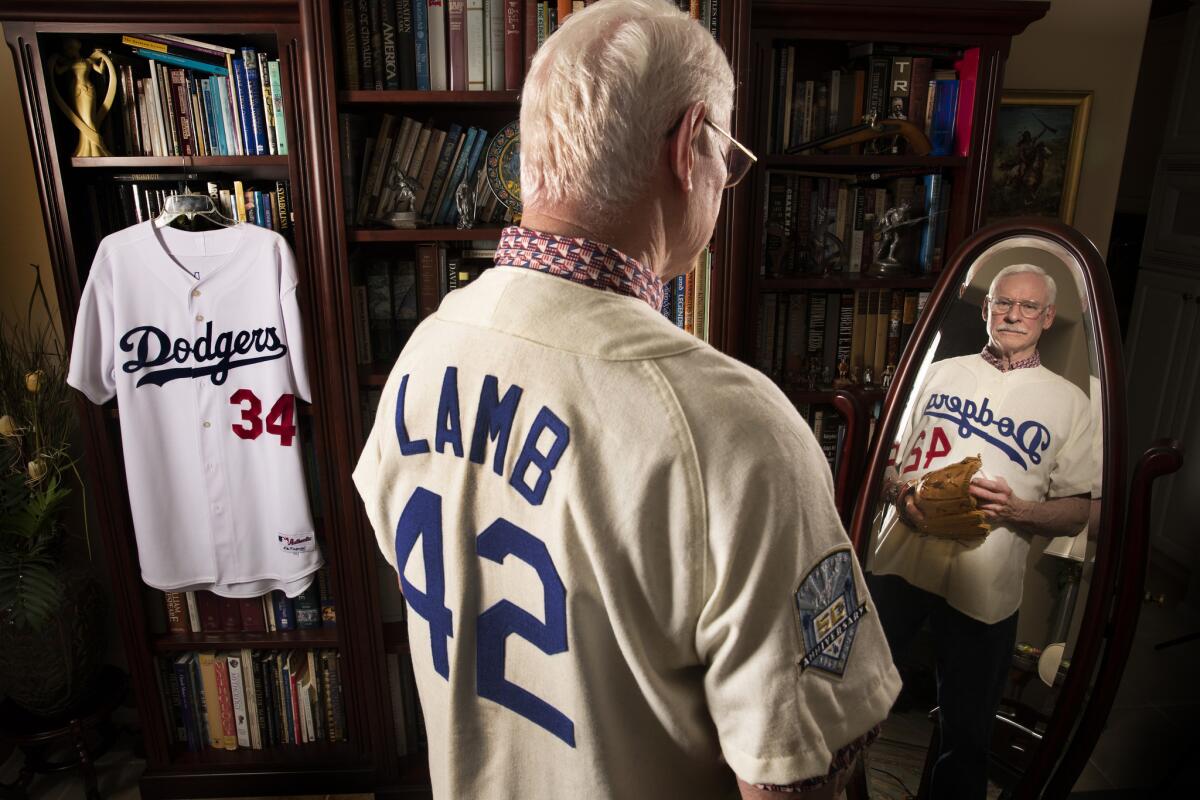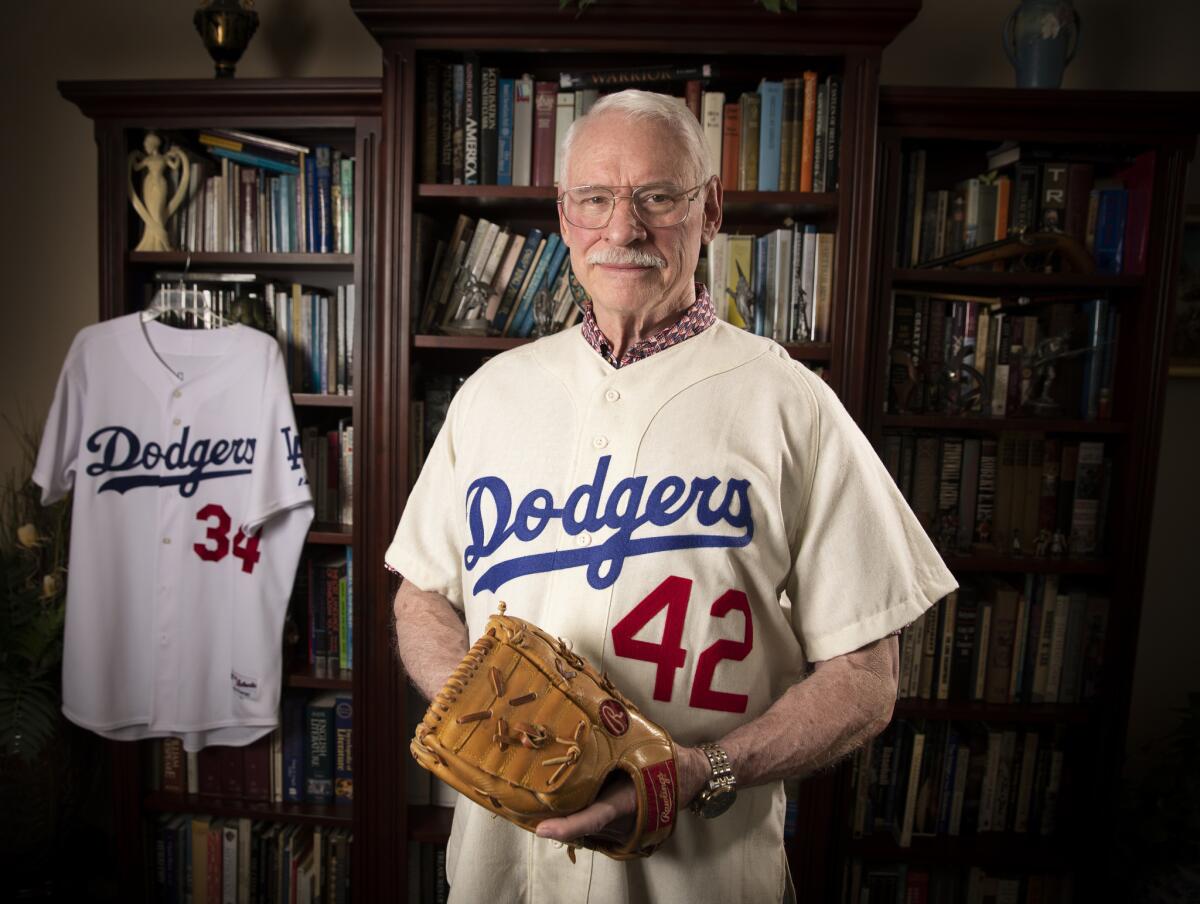Column: Meet Ray Lamb, the last Dodger to wear Jackie Robinson’s No. 42 — by mistake

- Share via
It is the most revered number in all of sports, the first number retired by an entire sport, a number that will forever belong to one man.
The No. 42 worn by Jackie Robinson has been immortalized in the Dodgers annals, affixed to a Dodger Stadium wall, and deemed untouchable by any Dodgers player since then.
Well, almost untouchable.
This is a story of one of the biggest mistakes in Dodgers history, a mistake that lasted only two months but will be remembered for a lifetime.
This is how, in August 1969, the No. 42 was misguidedly given to a Dodgers rookie relief pitcher named Ray Lamb.
He was the first Dodger to wear that number since Robinson retired a dozen years earlier. He wore it for the rest of the 1969 season before the Dodgers’ venerable clubhouse manager Nobe Kawano realized his error and snatched it away.
“I’ve got to have this number back because we’re going to eventually retire it,’’ Kawano said.
Sign up for our daily sports newsletter »
“Did I have that good of a year?’’ Lamb said.
Actually, for a Glendale kid who lasted five seasons in the major leagues, the mistake was magic.
With his back covered in the jersey of baseball’s toughest pioneer, the bespectacled right-hander pitched fearlessly during what became probably the two best months of his career.
In 10 appearances he had a 1.80 earned-run average with one loss and one save. In 15 innings he struck out 11 batters. The first batter he faced that season was Joe Torre, whom he eventually tagged out on a play at the plate. The last batter he faced was Pete Rose; he fooled him into a groundout.
For two months, it was like the spirit of Jackie Robinson lived in that jersey.
“Like a dream,’’ Lamb said.
::
It is the coolest tribute in the sports world’s most compelling annual celebration. When baseball observes Jackie Robinson Day on Monday, every player on every team will wear No. 42 in honor of Robinson breaking baseball’s color barrier April 15, 1947.
When Lamb, 74, has watched the ceremonies on TV from his San Clemente home, he has had two thoughts.
First, “Jackie Robinson was such a great man, it is such an honor to even be remotely associated with him.’’
Second, ‘’Hey, look at all those people wearing my jersey!’’
The No. 42 jersey was hanging in his locker at St. Louis’ Busch Stadium when he showed up from triple-A Spokane on Aug. 1, 1969. Lamb didn’t think twice about putting it on. He was a former USC pitcher who wore that number for the Trojans, so it just made sense.
The Dodgers initially didn’t think twice about giving it to him. The organization had been in Los Angeles only 11 years and was still attempting to create its local history. Since Robinson never played in Los Angeles, they were marketing their new heroes.
“Retiring Brooklyn Dodger numbers just wasn’t on their radar,’’ said Mark Langill, Dodgers team historian. “Their focus was on establishing a Los Angeles presence.’’
According to Langill, the first Dodgers old-timers games involved not Brooklyn Dodgers, but players from the Pacific Coast League. One of their biggest promotional nights involved not former players, but Hollywood stars.
“They didn’t bring that Brooklyn Bum character west with them, they weren’t about that,’’ Langill said. “They were about establishing their own identity.’’

Wearing that iconic jersey in that first season, Lamb soon also established his identity. He was the hard-throwing right-hander who was once a 40th-round draft pick and somehow climbed into the show. He slept in his Glendale childhood bedroom, invited his high school buddies to the games and lived the dream.
His first home game was a promotional night, a sellout with the Chicago Cubs in town, and he was so nervous when he entered the game that while throwing his first warmup pitch he dropped the ball.
“The whole stadium was laughing at me,’’ he said.
But soon Chavez Ravine was rocking as he threw 3 1/3 scoreless innings, giving up only one hit.
“My parents were in the stands, I lived right down the street, everyone was cheering … it was magical,’’ he said.
The magic continued with two more scoreless appearances leading up to a ninth inning in Philadelphia where he surrendered a leadoff home run to Dick Allen but then retired three consecutive Phillies for his first of only four career saves. He gave up a run in only one of his final five appearances, a home run to Atlanta’s Hank Aaron.
The mystical effect of the jersey, perhaps, also led to a unique occurrence in the seventh inning of a Sept. 1 game at Dodger Stadium against the New York Mets. Lamb had retired the final batter in the top of the seventh inning and was scheduled to bat in the bottom of the inning, but was replaced by a smiling pinch-hitter with giant forearms.
Making his major league debut was Steve Garvey.
“A lot of little things like that happened that year,’’ Lamb said.
While strolling through Dodger Stadium during the end of that season, Lamb kept seeing photos of Robinson and his No. 42 jersey, and he finally made the connection.
“Nobody said anything to me during the year,” he said, “but looking at those photos, it dawned on me, and I was like, ‘Oh man.’ ’’
It dawned on the Dodgers, too, and at the end of the season, before Lamb could put his jersey in his duffel bag, Kawano grabbed it. The number was officially retired by the Dodgers three years later.
“There was no big outcry that Ray was wearing 42, you’d be hard pressed to find a newspaper column on it, nobody thought anything about it,’’ Langill said. “But the Dodgers realized what they needed to do.’’
Lamb never wore the jersey again, and his experiences were never quite the same. He pitched one more season for the Dodgers, finishing 6-1 with a 3.79 earned-run average, before being traded to the Cleveland Indians. He pitched three more seasons there before his career ended with a shoulder injury and a cold shoulder from baseball’s front office after he was an outspoken player representative for a growing union.
He finished his career with a 20-23 record and 3.54 ERA, and later found greater and most lasting success as a commercial sculpturer who created replicas of the many fantasy characters found in games like Dungeons & Dragons.
There are dozens of the tiny figurines on display in the living room case of the San Clemente home he shares with wife Dianne. There are only two sports artifacts among the little sculptures. Both are tiny trophies from his youth baseball days.
The famous jersey? It’s not on display. He has two of them, wrapped in plastic, hanging in a closet, both given to him by the Dodgers during an old-timers’ celebration in 2008.
Nobody ever requests to see them. Few have any idea of his relation to them.
“It’s like nobody knows, and nobody asks,’’ he said.
There are few photos of him actually wearing the Dodgers No. 42 jersey. In fact, he has found only one, a faded newspaper clipping from the Glendale News Press. Even his baseball card, which one might think would be worth plenty, reveals nothing. It’s a rookie card, and it only shows him from the shoulders up without any trace of the actual jersey.
He hasn’t been to Dodger Stadium since 2008 because of the strain the drive places on his aching body. When he was last there, the Dodgers announced the number quirk, and folks lined up for his autograph, but few folks have mentioned it since.
It’s almost as if it never happened, almost like Robinson’s legacy dictated that Lamb would get those two magical months in his jersey and then it would be completely stricken from everyone’s memory.
But he remembers. He’ll never forget a brief season that felt like summer camp, hanging out with Maury Wills and Don Drysdale, working for Walt Alston, wearing baseball’s most iconic number with pride.
‘’It was really something special,’’ he said.
Lamb also will never forget what number was hanging in his Dodgers locker the next season. It is another number in which he was just a temporary visitor on its path to immortality.
He went from wearing Robinson’s No. 42 to wearing Fernando Valenzuela’s No. 34, thus becoming the only Dodger in history who wore two numbers that will never be worn again.
Get more of Bill Plaschke’s work and follow him on Twitter @BillPlaschke
More to Read
Are you a true-blue fan?
Get our Dodgers Dugout newsletter for insights, news and much more.
You may occasionally receive promotional content from the Los Angeles Times.










